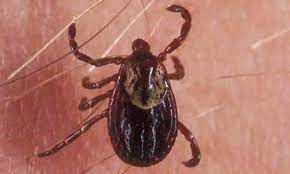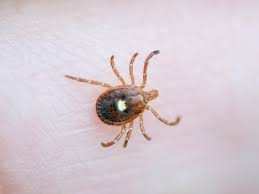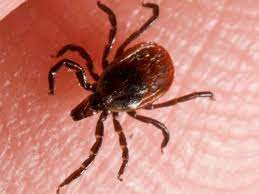
UNDATED – When you find a tick crawling through your hair or stuck to your skin, two thoughts probably pop into your mind immediately: How do I get this thing off of me? And: Should I be freaking out right now?
Ticks aren’t bugs (or insects) at all. Ticks are different in several ways. Ticks have two body parts and eight legs, where insects have three body parts and six legs. There are many species of ticks in Indiana, but the three most common ones are the American dog tick, Lone Star tick, and Black-legged tick and all of these are usually pretty harmless to people.

The American Dog tick is the most common of the three. This large slow-moving tick is usually gray to dark brown in color. Perhaps this tick earned its name from its favorite food host, your dog. The larva of this tick prefers wild mammals or your pets to feed on. However, the adult will use its short mouth to feed on us as well.

The second most common tick is the Lone Star tick, aka the Seed tick, turkey tick, or Deer tick. It may be smaller than the American dog tick, but with its longer mouth, it sure has a bigger bite. The female is easily recognized by the white spot on the center of her back.

The Black-legged tick was established in Indiana in 1987 and quickly became the most feared. This tiny mahogany-colored oval is known for carrying Lyme disease that most of us are worried about getting from tick bites. In reality, the black-legged tick would rather feed upon mice, small rodents, and white-tailed deer.
Indiana ticks may carry two other diseases besides Lyme disease. The two other most common diseases are Mountain Spotted Fever and Ehrlichiosis. Symptoms for these three diseases range from spreading rashes, headaches, fatigue, fevers, to muscle aches. Although your chances of contracting these diseases are pretty rare, if you are bitten the best action to take is to remove the tick, save it and label it in a jar in case symptoms develop.
The majority of tick bites are painless or only cause a little redness, itching, and swelling. They can be treated at home by removing the tick and cleaning the area.
You may be thinking “There’s no way I’m hiking now!” But remember, the chances of contracting one of those diseases are pretty slim and there are precautions to take to protect against being bitten. All you need to do is to follow these four easy suggestions: wear long pants and long-sleeved shirts, tuck shirts into pants and pants into socks, use insect repellant, and always check for ticks when you leave the woods. Be prepared, and don’t worry about feeling “bugged out” by ticks.
If you plan to spend lots of time in your backyard or hiking this spring and summer, it helps to be able to differentiate between mild and serious symptoms of a tick bite and how to avoid these creepy crawlers in the first place.
Here’s what you need to know.
What are the symptoms of a tick bite?
One important thing to remember: you should still find and remove any ticks on your body after being outside just in case.
When a “normal” tick bites you, it injects a small amount of a chemical to thin your blood to make it easier for the tick to ingest. That chemical may cause a mild allergic skin reaction.
Those immediate reactions can include:
- A small red spot at the bite site
- Minor swelling
- itchiness
Usually, these are nothing to worry about, and there’s no need to contact a healthcare provider if you’re not having any other symptoms.
That said, you should be on the lookout for symptoms that crop up after a tick bite the Center for Disease Control recommends watching and waiting for 30 days to see if you develop any additional symptoms that could signal a tick-borne disease. The main symptom of a possible infection is a fever.
Symptoms of a tick-borne disease can include:
- A fever of 101 degrees Fahrenheit (38.3 degrees Celsius) or higher
- A skin reaction or rash that’s over a centimeter in size
- A red, pink, or salmon-colored halo-shaped or bulls-eye rash surrounding the bite site
- Flu-like symptoms such as chills, sweats, headache, muscle aches, fatigue, joint pain, or swollen lymph nodes
- Signs of infection like oozing or red streaks from the bite site
Any of those symptoms following a suspected tick bite are a cue to seek medical attention.
Outside of a local reaction or later symptoms of a tick-borne disease, you should also see a doctor immediately if you show any signs of a severe allergic reaction from a tick bite (aka anaphylaxis) or tick paralysis, which is extremely rare, per the CDC. Those symptoms can include:
- Chest pain
- Wheezing or trouble breathing
- Heart palpitations
- Nausea or vomiting
- Paralysis or the inability to move different parts of your body
- A severe headache
The best game plan to prevent tick-borne diseases is to avoid ticks in the first place. Here’s how the CDC recommends doing that:
- Stay on the beaten path. Avoid wandering off trails or into tall grasses, and keep your grass well-trimmed in your yard.
- Cover up. Wear long sleeves and pants, and tuck pant legs or leggings into long socks.
- Use a strong tick repellent. Regularly apply and reapply tick sprays registered by the Environmental Protection Agency (EPA) that contain DEET, picaridin, IR3535, oil of lemon eucalyptus (OLE), para-menthane-diol (PMD), or 2-undecanone.
- Tick-proof your gear. Keep ticks off your clothes, boots, tent, blankets, and more with a specially formulated 0.5 percent permethrin spray (which naturally irritates on contact).
- Do a full-body check. To ensure you’re tick-free, scan under your arms and knees, in and around your ears and hair, between your legs, and everywhere else. Don’t forget to check pets, too.
- Wash them off. After spending time in tick territory, take a shower as soon as you can and throw your clothes in the laundry on high heat to zap any crawlers.
If you do happen to find a tick on you, the best way to remove it is to use a small pair of tweezers or a tick key to gently grasp onto the head and pull it away from your body Then, thoroughly clean the area with soap and water or an antiseptic like rubbing alcohol.
If you become sick after being bitten, your doctor can determine the best treatment plan depending on the cause and severity of your illness.



